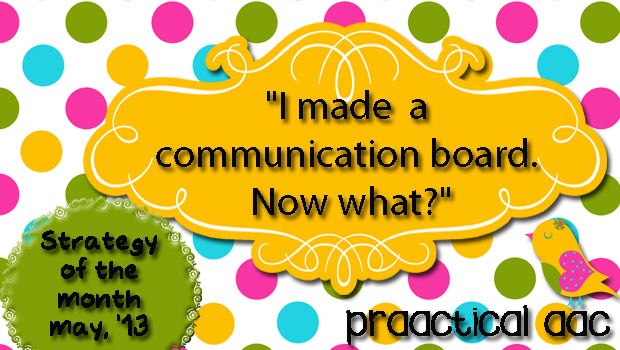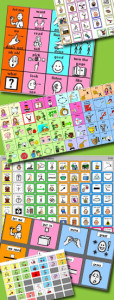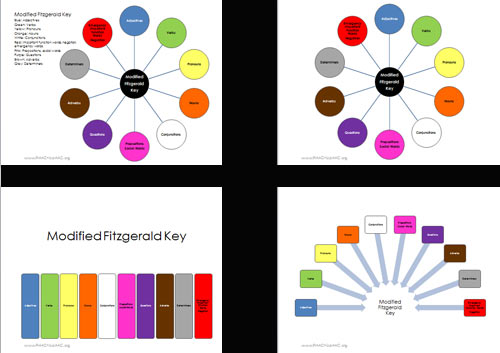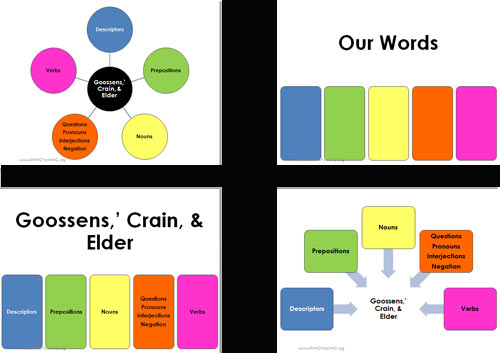“I Made a Communication Board. Now What?”

Earlier this month, we shared some ideas for making communication boards using color coding and also for creating boards geared to different communicative purposes. Making the communication board according to some basic principles is a good thing, of course, and it takes a decent amount of thought and planning. Even more important, though, is developing an intervention plan so that the augmentative communicator learns how to use the board effectively. Here are some of our thoughts on how to teach someone to use a new communication board.
an intervention plan so that the augmentative communicator learns how to use the board effectively. Here are some of our thoughts on how to teach someone to use a new communication board.
Model It
We’ve talked about aided language input so many times that I’m almost embarrassed to mention it. Almost. The truth is, it is a ‘must do’ strategy when we’re first introducing a communication board, book, SGD, or AAC app. Incidental learning is important for just about all of the people with whom we work. It is never the only strategy we use, but it’s almost always the one we start with.
Create Frequent Opportunities for Use
When tools are easy for us to use and don’t require a lot of thought, planning, or effort, we tend to use them readily to meet whatever the need is. The same is true for people who use AAC, but getting them to the point where they feel sufficiently competent with the AAC tools we’re introducing takes time. It takes less time if we load them up with lots and lots of teaching and practice opportunities.The task here is to work with the learner’s team to infuse opportunities to learn about and use the communication board all day long. There is no separate ‘communication time.’ Rather the communication board gets used at every possible opportunity. Whenever I see the client, the communication board should be right along with him/her. If it is rich in core vocabulary, then the communication board has pronouns, verbs, descriptors, prepositions, interrogatives, and other words that are as appropriate in the classroom as they are on the playground, bus, bathroom, therapy room, bedroom, kitchen, backyard, store, restaurant, doctor’s office, waiting room, gym, park, library, clinic, Grandma’s house, porch, car, etc. Communication boards work everywhere: Don’t leave home without ‘em!
Give an Orientation
When we got a new car last year, the dealer spent a view minutes orienting us to the dashboard. When I got a new app recently, I watched a video that gave an overview of the features. When I introduce my AAC class to an SGD for the first time, we go over the parts and review the ‘anatomy’ of a communication device. Explanations matter. They may not be the only strategy we need to learn a new tool, but they sure help get us started. For some reason, though, SLPs tend not to do this when we provide our clients with a new AAC tool. We’d like to advocate for a brief period of orientation when we introduce communication boards and other tools so we can explain the basic layout. It’s standard procedure with adult clients, but for some reason we tend not to use this strategy with kids, particularly if there are intellectual disabilities. We’ve found it to be useful, though, for at least some children.
Use your best clinical judgment for how to do this in a way that facilitates understanding by your client. Generally, that means brief, simple, direct, and with visual input. Most times, we use a slower rate of speech to give time for the learner to look, listen, and process the information we’re sharing. This is not an appropriate strategy for beginning communicators who are just getting started with their AAC systems, particularly if their receptive language skills are extremely impaired. However, for people who are beginning to combine words into sentences, we try to presume competence by explaining how their communication board is set up.
Teach the Patterns
Human beings are pattern-seekers. We use patterns to help us make sense of things and to remember them. Why not use this to our advantage when teaching people to use communication boards effectively? If we used color coding to create a board with pronouns that have yellow backgrounds or borders, for example, then it makes sense to teach that strategy to the learner. Here are some thoughts on how to do that. Not everything works for every learner, so choose the ones that are best-suited to your particular situation.
-
Create a visual support: Having a visual representation of the color-coding schema available to look at and refer to during the therapy session makes teaching clearer. We can reference this as we talk about the words, their part of speech, and the color coding strategy. You can download an example of the ones we made for both the Modified Fitzgerald Key and the Goossens,’ Crain, and Elder schemas.
-
Use a think-aloud strategy: “Hmm. I want to say ‘go’ and I know that’s an action word. Those are green. Let me look through the green ones. [scanning down the board] Get…give…GO!”
-
Model with aided language input and draw attention to the colors as you do
-
Use activities designed to highlight the patterns: We might do a scavenger hunt, for example, where we look for all the blue adjectives or pink prepositions on our board.
 We might adapt a board game where we draw cards with different colors and then use the communication board to say a word from that part of speech (color category). We could develop a word sort activity where we look at a word or picture and decide whether it belongs in the green/verb pile or goes with the orange/nouns. We might develop a fill-in-the-blank worksheet with colored blanks so that the learner has to pick a word from that part of speech/color category to complete the sentence. Once you start thinking about your learner and the materials you have at hand, it’s pretty easy to come up with activities that match the goal.
We might adapt a board game where we draw cards with different colors and then use the communication board to say a word from that part of speech (color category). We could develop a word sort activity where we look at a word or picture and decide whether it belongs in the green/verb pile or goes with the orange/nouns. We might develop a fill-in-the-blank worksheet with colored blanks so that the learner has to pick a word from that part of speech/color category to complete the sentence. Once you start thinking about your learner and the materials you have at hand, it’s pretty easy to come up with activities that match the goal. -
Highlight it in sentence-building activities: Activities that give specific instruction on creating sentences using color patterns can be very beneficial to some AAC learners. Those of us who have (ahem) been around awhile remember using the Fokes Sentence Builder, a color-coded template for creating sentences that have a predictable pattern (e.g., The noun is verb+ing. The noun is verb+ing + prepositional phrase). Marcia Sterner and the AT Team at OCPS have created Boardmaker templates for the basic schema, who/what doing, which/where using a modified Fitzgerald Key. There are commercially available programs and apps that do this sort of thing, such as Alien Talk and Colourful Semantics, but this can be a bit confusing if the color-coding system used in the app differs from the one that the AAC users have on their communication boards/books and/or SGDs.
Many of the strategies that work for introducing SGDs, AAC apps, and other communication tools work perfectly well with communication boards, too. You can read some of Robin’s suggestions for building skills with a new communication book here. There are lots of ways to do it; The main thing is to teach, rather than just provide access to the new tool and ‘hope’ the person uses it. Any teaching strategy is better than none at all.
Finally, manage your expectations. Teaching your client to use the new communication board will take time. It’s not going to happen in a week, or maybe a month. It takes time. As our friend, Jane Farrall, said recently, “The road to great outcomes can be so much longer than the road to poor outcomes.” Help the team understand that by doing the things mentioned above, they are laying a solid foundation and that takes time. We all love to get immediate results, but the more realistic scenario is slow and steady gains. If the team knows to expect this, it’s easier for them to stay the course. When we expect big changes to happen quickly and then they don’t, we tend to lose enthusiasm for the approach. Gear the team for success by preparing them that using good teaching strategies will allow the AAC learner to use the communication board, but it takes time.
For more tips on making and teaching ‘no tech’ AAC tools, check out some of our earlier posts on communication books. Do you have tips or thoughts on teaching people to use communication boards? We’re always looking for input and would love any comments you’d care to leave.
Fokes, J. (1976). Fokes Sentence Builder. Boston: Teaching Resources Corporation.
Filed under: Strategy of the Month
This post was written by Carole Zangari

2 Comments
Great post – thanks Carole! So true that the communication book is only the first part of our work – not the end!
It’s remarkable to visit this web site and reading the views of all
colleagues about this post, while I am also keen of getting familiarity.